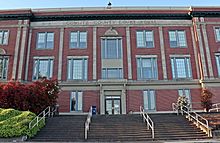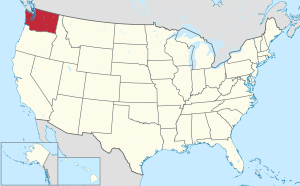Cowlitz County, Washington facts for kids
Quick facts for kids
Cowlitz County
|
|
|---|---|

Cowlitz County Courthouse
|
|

Location within the U.S. state of Washington
|
|
 Washington's location within the U.S. |
|
| Country | |
| State | |
| Founded | April 21, 1854 |
| Seat | Kelso |
| Largest city | Longview |
| Area | |
| • Total | 1,166 sq mi (3,020 km2) |
| • Land | 1,140 sq mi (3,000 km2) |
| • Water | 26 sq mi (70 km2) 2.2%% |
| Population
(2020)
|
|
| • Total | 110,730 |
| • Estimate
(2022)
|
111,956 |
| • Density | 94.97/sq mi (36.666/km2) |
| Time zone | UTC−8 (Pacific) |
| • Summer (DST) | UTC−7 (PDT) |
| Congressional district | 3rd |
Cowlitz County is a county located in the U.S. state of Washington. As of the 2020 census, its population was 110,730. The county seat is Kelso, and its largest city is Longview. The county was formed in April 1854. Its name derives from the anglicized version of the Cowlitz Indian term Cow-e-liske, meaning either 'river of shifting sands' or 'capturing the medicine spirit.' Cowlitz comprises the Longview, WA Metropolitan statistical area, which is also included in the Portland-Vancouver-Salem, OR-WA Combined statistical area.
Contents
History
Prior to the Europeans' arrival to the area, it was inhabited by numerous Native American tribes, with the Cowlitz tribe being the largest. They were drawn to the region by the abundance of salmon. The Cowlitz are considered to be the first regional inhabitants to engage in commerce as they traded extensively with other tribes in Western and Eastern Washington. The Cowlitz Indian population declined significantly from the 1829-1830 smallpox outbreak.
European explorers discovered and began navigating the Columbia River in 1792 as British Lieutenant W. R. Broughton sailed up the river to and past present day Cowlitz County. Then on November 5, 1805, Lewis and Clark camped at the mouth of the Kalama River. Over the following days, they would reach the present sites of Kelso and Longview.
By the 1820s, the Hudson's Bay Company had established a lucrative fur trade in the region. Furs were shipped down the Cowlitz River to the Columbia where they were loaded and shipped around the world. Trade declined significantly in the late 1830s as over-hunting reduced the annual yields, and wearing fur had become less fashionable.
During the next several decades, white settlement of the region was in full swing. Most of the settlers homesteaded near the tributaries that fed the Columbia River, forming settlements. The first was Monticello, near present-day Longview. In 1841 several families with the HBC directed Sinclair expedition from Red River Colony settled there.
On November 25, 1852, at Monticello, settlers from the Cowlitz and Puget Sound regions drafted a petition (the Monticello Convention) to the federal government, calling for a separate territory north of the Columbia River to be carved out of the existing Oregon Territory. The petition was successful; three months later the United States Congress formed the Columbia Territory, although it was soon renamed Washington Territory.
The newly separated territory was governed by two existing counties. In August 1845, the Oregon Territorial government had created Vancouver County. Its boundary covered the entire area of present-day Washington state. In December of that same year, the Oregon Territorial government sliced off the eastern portion to create Lewis County. In 1849 the reduced Vancouver County was renamed Clark County. So when the new Washington Territorial government began functioning, among its first actions was the creation of Cowlitz County, from the southwestern portion of Clark County. This proclamation was finalized on April 24, 1854, signed into law by Governor Isaac Stevens. Later in 1854, the western portion of the new county was partitioned off to form Wahkiakum County; otherwise the county's boundary has remained unchanged until the present.
Nearly every town that sprang up in the late 19th century began around a logging or lumber-milling operation. In the latter half of the 1920s, the Weyerhaeuser Company and Long-Bell Lumber Company established processing facilities. At the time, these two facilities were the first and second largest in the world. The county is still heavily dependent on the timber industry.
Four towns have functioned as the Cowlitz County seat:
- Monticello (1854–1865)
- Freeport (1865–1872)
- Kalama (1872–1922)
- Kelso (1922–Present)
Geography
Cowlitz County is in the southwestern part of Washington state. According to the U.S. Census Bureau, the county has a total area of 1,166 square miles (3,020 km2), of which 1,140 square miles (3,000 km2) is land and 26 square miles (67 km2) (2.2%) is water.
Cowlitz County is part of the Puget Sound – Willamette Depression, a geologic formation extending southward from the Puget Sound to the Willamette Valley in Oregon. Nestled against the Cascade Mountains, many of the county's major rivers originate in this range, including the Columbia, Cowlitz, Coweeman, Kalama, Lewis and Toutle.
Cowlitz County is one of the state's smaller counties (28 of 39).
Geographic features
Major highways
Adjacent counties
- Lewis County - north
- Skamania County - east
- Clark County - south
- Wahkiakum County - west
- Columbia County - south
National protected areas
County parks
- Catlin Cemetery
- Cougar Wayside
- Finn Hall Wayside
- Harry Gardner Park
- Hog Island Access
- Riverside Park
- SRS Viewpoint
- Woodbrook Park
Demographics
| Historical population | |||
|---|---|---|---|
| Census | Pop. | %± | |
| 1860 | 406 | — | |
| 1870 | 730 | 79.8% | |
| 1880 | 2,062 | 182.5% | |
| 1890 | 5,917 | 187.0% | |
| 1900 | 7,877 | 33.1% | |
| 1910 | 12,561 | 59.5% | |
| 1920 | 11,791 | −6.1% | |
| 1930 | 31,906 | 170.6% | |
| 1940 | 40,155 | 25.9% | |
| 1950 | 53,369 | 32.9% | |
| 1960 | 57,801 | 8.3% | |
| 1970 | 68,616 | 18.7% | |
| 1980 | 79,548 | 15.9% | |
| 1990 | 82,119 | 3.2% | |
| 2000 | 92,948 | 13.2% | |
| 2010 | 102,410 | 10.2% | |
| 2020 | 110,730 | 8.1% | |
| 2022 (est.) | 111,956 | 9.3% | |
| U.S. Decennial Census 1790–1960 1900–1990 1990–2000 2010–2020 |
|||
2020 census
As of the 2020 census, there were 110,730 people and 42,776 households in the county. The population density was 97.0 people per square mile (37.5 people/km2). The racial makeup of the county was 90.4% White, 1.7% Asian, 2.2% American Indian, 1.2% African American, 0.5% Pacific Islander, and 4.0% from two or more races. Those of Hispanic or Latino origin made up 9.9% of the population.
22.5% of the population of the county was under 18, and 5.8% were under 5. People over 65 represented 19.4% of the population. The gender ratio was equal, with 50% of the population being female and 50% being male.
The median income for a household in the county was $64,506, and the per capita income was $32,439. 12.6% of the population was below the poverty line.
2010 census
As of the 2010 census, there were 102,410 people, 40,244 households, and 27,241 families living in the county. The population density was 89.8 people per square mile (34.7 people/km2). There were 43,450 housing units at an average density of 38.1 units per square mile (14.7 units/km2). The racial makeup of the county was 88.9% white, 1.5% Asian, 1.5% American Indian, 0.6% black or African American, 0.2% Pacific islander, 3.5% from other races, and 3.7% from two or more races. Those of Hispanic or Latino origin made up 7.8% of the population. In terms of ancestry, 24.4% were German, 15.0% were Irish, 12.3% were English, 6.2% were Norwegian, and 5.4% were American.
Of the 40,244 households, 31.8% had children under the age of 18 living with them, 50.2% were married couples living together, 11.8% had a female householder with no husband present, 32.3% were non-families, and 25.8% of all households were made up of individuals. The average household size was 2.51 and the average family size was 2.99. The median age was 40.2 years.
The median income for a household in the county was $45,877 and the median income for a family was $55,002. Males had a median income of $48,329 versus $32,438 for females. The per capita income for the county was $22,948. About 11.8% of families and 16.9% of the population were below the poverty line, including 23.3% of those under age 18 and 7.1% of those age 65 or over.
Communities
Cities
- Castle Rock
- Kalama
- Kelso (County seat)
- Longview
- Woodland (Partly in Clark County)
Census-designated places
- Beacon Hill
- Cougar
- Lexington
- Longview Heights
- Ryderwood
- West Side Highway (former)
Unincorporated communities
Columbia Heights, Washington Lexington, Washington
See also
 In Spanish: Condado de Cowlitz para niños
In Spanish: Condado de Cowlitz para niños

